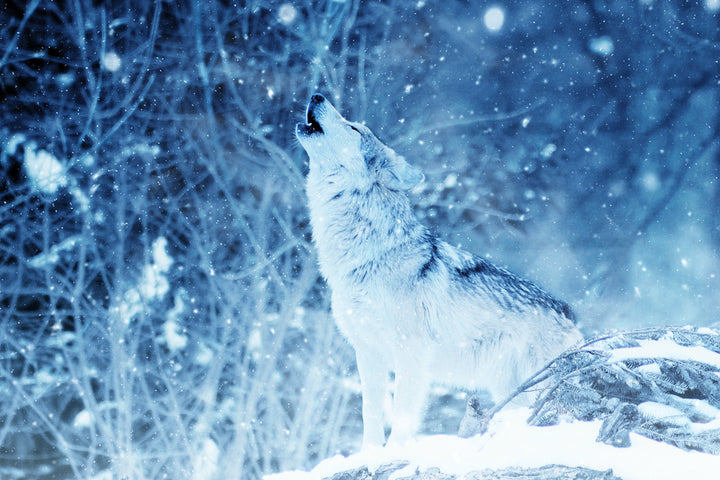Hungry Like a Wolf
Squint hard enough while you are watching your chihuahua chowing down on a meaty treat and you can almost see the wolf in there, right? Turns out that domestic dogs and wolves are actually more similar (genetically speaking) to each other than wolves and coyotes. Dogs and wolves can mate and produce fertile offspring, another sign they are far more similar than different, despite superficial differences in appearance. (This article has some great information about wolves. If you find them as fascinating as I do, give it a read!)
Modern Dogs, Ancient Physiology
When you start to look at modern canine physiology, you realise just how little dogs have changed in terms of their nutritional needs. Did you know, for example, that dogs do not have enzymes in their saliva? Unlike humans, who do, they do not begin the digestion process before swallowing. Instead, all that drool they produce just helps their food slide smoothly down the hatch until it hits their stomach.
Powerful Stomachs Love Raw Diets
Dog stomachs are large and strong, which allows them to eat big meals, fast - a throwback to when they gorged on a fresh kill and then had a good long nap. Full of loads of potent stomach acid, their guts are designed to make short work of meat and bone and also deal with heavy loads of bacteria that may be present in uncooked food. That’s why they generally have no trouble eating that disgusting, half-rotten ‘what the hell was that?’ dead thing they found while on a walk. We might be flapping our hands in panic and suppressing the urge to gag, but often dogs are able to handle consuming stuff that would kill us off in pretty quickly. Which is not to suggest that it’s a good idea to let your dog eat any old thing he finds while nosing about in the bushes, but does serve as a good reminder that kissing your dog on the lips is not necessarily a good idea!
It’s Up to Us to Provide the Best for Our Dogs!
Understanding how a dog’s digestive system works, though, is helpful given that we have taken over the responsibility of providing them with their daily grub. A complete and well-balanced raw food diet turns out to be best-suited to your dog’s particular needs, not just in terms of the nutrients it contains, but also the way in which those nutrients are packaged. Kibble expands in the stomach, so dogs will often eat too much and then experience bloating after the fact. Raw meat, on the other hand, does not expand after eating and is easily handled by the design of your dog’s stomach.
Dogs Don’t Need Grains
A dog’s digestive system produces far fewer digestive enzymes than some other species (like us, for example - a dog has quite a puny pancreas by comparison). As a result, dogs are not designed to consume large amounts of grain or starchy foods. Kibble may contain various types of fillers, including wheat, corn, rice, and soy, none of which dogs are well-suited to digest. Wheat or gluten sensitivity may develop (certain breeds like Irish Setters and Samoyeds are more susceptible) and, like the rest of us, too many carbs can lead to excessive weight gain.
My, What Big Teeth You Have!
Look into a dog’s mouth and you get another clue about the ideal canine diet. A dog’s canines are sharp and designed to tear meat. Strong jaws are able to exert tremendous pressure, enough, in fact, to crush bones. Kibble can contribute to poor dental health as it crumbles when eaten. Residue may get caught between the teeth or under the gum line. Irritation may result and food residue can contribute to bad breath. Crunching bones helps scrape the teeth clean and many owners have noticed that a dog fed a raw diet does not suffer from the same nasty breath of some kibble fed dogs.
Other health benefits of a complete and balanced raw dog food diet include a glossy, healthy coat with less shedding, reduced allergies and skin irritation, and bright, clear eyes. Digestive troubles can be reduced or eliminated entirely by switching to a well-balanced, whole, naturally raw food diet like Rawmate.
It’s A Dog’s Life
All that said, though our canine companions have a lot in common with their wolf cousins, in the wild, wolves in the wild have a life expectancy of between six and eight years. Dogs, because of advances in veterinary care, immunisations, dental care, no competition for food, and the comforts of home that make it less likely they suffer from unfortunate accidents, have a life expectancy of somewhere between 10 and 15 years (smaller dogs tend to live longer). Feeding an optimal diet will help make sure your dog is healthy and active for as many years as possible. For more information about our feeding plans and what we include to make sure your dog is getting exactly what he needs at different stages in her life, check out our Rawmate ingredients here.







There are 0 Comments